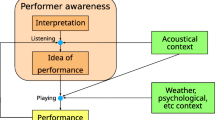Abstract
In this paper, we describe a CBR system for applying musically acceptable tempo transformations to monophonic audio recordings of musical performances. Within the tempo transformation process, the expressivity of the performance is adjusted in such a way that the result sounds natural for the new tempo. A case base of previously performed melodies is used to infer the appropriate expressivity. Tempo transformation is one of the audio post-processing tasks manually done in audio-labs. Automatizing this process may, therefore, be of industrial interest.
Preview
Unable to display preview. Download preview PDF.
Similar content being viewed by others
References
Arcos, J.L., Grachten, M., López de Mántaras, R.: Extracting performer’s behaviors to annotate cases in a CBR system for musical tempo transformations. In: Ashley, K.D., Bridge, D.G. (eds.) ICCBR 2003. LNCS, vol. 2689, Springer, Heidelberg (2003)
Cambouropoulos, E.: Melodic cue abstraction, similarity and category formation: a formal model. Music Perception 18(3), 347–370 (2001)
Desain, P., Honing, H.: Tempo curves considered harmful. In: Kramer, J.D. (ed.) Time in contemporary musical thought’. Contemporary Music Review, vol. 7(2) (1993)
Friberg, A.: Generative rules for music performance: A formal description of a rule system. Computer Music Journal 15(2), 56–71 (1991)
Gómez, E., Gouyon, F., Herrera, P., Amatriain, X.: Using and enhancing the current mpeg-7 standard for a music content processing tool. In: Proceedings of Audio Engineering Society, 114th Convention, Amsterdam, The Netherlands (2003)
Gómez, E., Klapuri, A., Meudic, B.: Melody description and extraction in the context of music content processing. Journal of New Music Research 32(1) (2003)
Grachten, M., Arcos, J.L., López de Mántaras, R.: A comparison of different approaches to melodic similarity. In: Second International Conference on Music and Artificial Intelligence, ICMAI (2002)
Grachten, M., Arcos, J.L., López de Mántaras, R.: In: Wiil, U.K. (ed.) CMMR 2004. LNCS, vol. 3310, pp. 347–358. Springer, Heidelberg (2005) (to appear)
Koffka, K.: Principles of Gestalt Psychology. Routledge & Kegan Paul, London (1935)
Levenshtein, V.I.: Binary codes capable of correcting deletions, insertions and reversals. Soviet Physics Doklady 10, 707–710 (1966)
Narmour, E.: The Analysis and cognition of basic melodic structures: the implication-realization model. University of Chicago Press (1990)
Narmour, E.: The Analysis and cognition of melodic complexity: the implicationrealization model. University of Chicago Press (1992)
Plaza, E., Arcos, J.-L.: Constructive adaptation. In: Craw, S., Preece, A.D. (eds.) ECCBR 2002. LNCS (LNAI), vol. 2416, pp. 306–320. Springer, Heidelberg (2002)
Serra, X., Lopez de Mantaras, R., Arcos, J.L.: Saxex: a case-based reasoning system for generating expressive musical performances. In: Proceedings of the International Computer Music Conference 1997, pp. 329–336 (1997)
Suzuki, T.: The second phase development of case based performance rendering system “Kagurame”. In: Working Notes of the IJCAI 2003 Rencon Workshop, pp. 23–31 (2003)
Temperley, D.: The Cognition of Basic Musical Structures. MIT Press, Cambridge (2001)
Widmer, G.: Machine discoveries: A few simple, robust local expression principles. Journal of New Music Research 31(1), 37–50 (2002)
Author information
Authors and Affiliations
Editor information
Editors and Affiliations
Rights and permissions
Copyright information
© 2004 Springer-Verlag Berlin Heidelberg
About this paper
Cite this paper
Grachten, M., Arcos, J.L., López de Mántaras, R. (2004). TempoExpress, a CBR Approach to Musical Tempo Transformations. In: Funk, P., González Calero, P.A. (eds) Advances in Case-Based Reasoning. ECCBR 2004. Lecture Notes in Computer Science(), vol 3155. Springer, Berlin, Heidelberg. https://doi.org/10.1007/978-3-540-28631-8_44
Download citation
DOI: https://doi.org/10.1007/978-3-540-28631-8_44
Publisher Name: Springer, Berlin, Heidelberg
Print ISBN: 978-3-540-22882-0
Online ISBN: 978-3-540-28631-8
eBook Packages: Springer Book Archive




